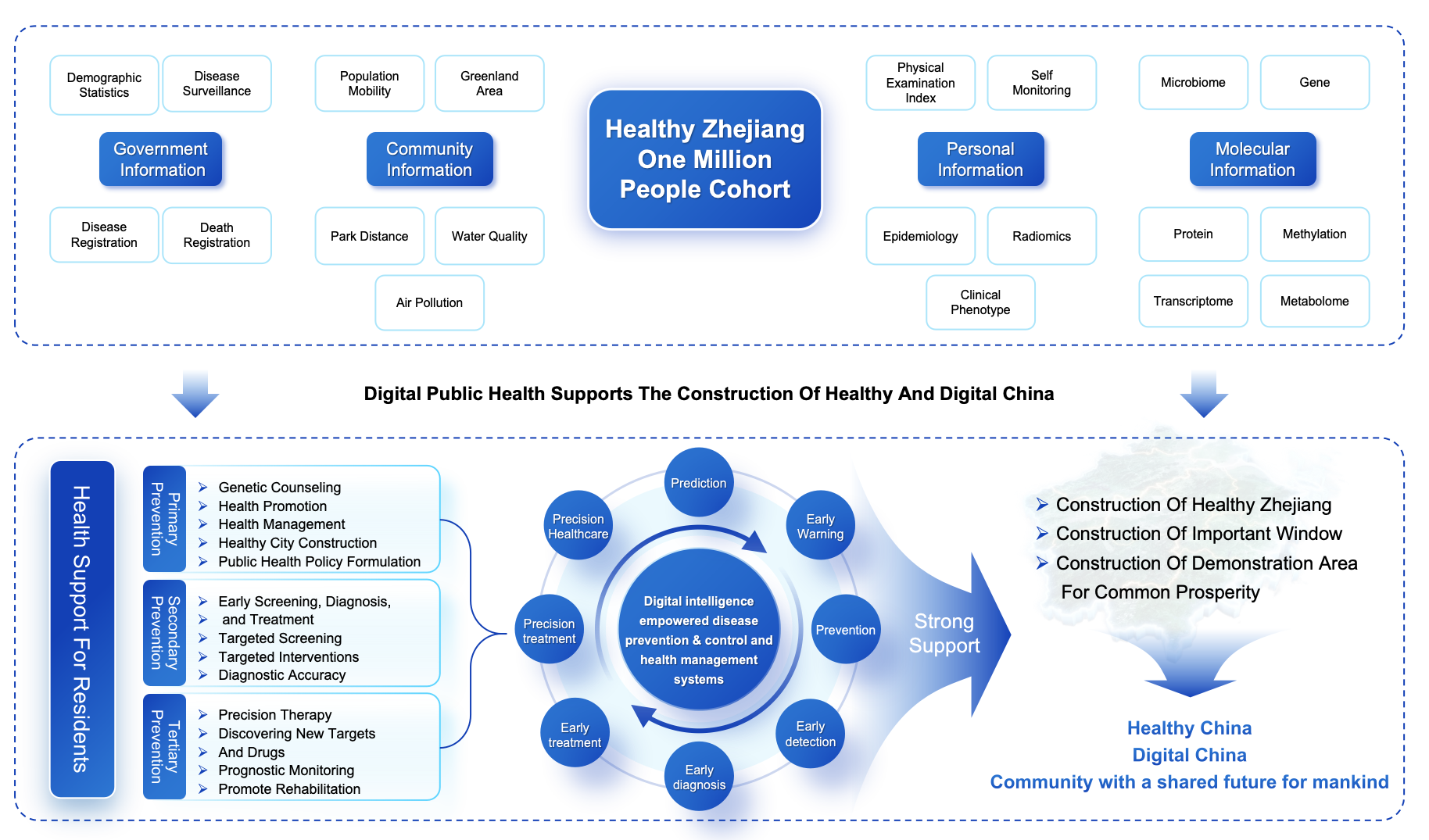In order to thoroughly implement the 'Healthy China' strategy, Zhejiang University, with the support of the Zhejiang Provincial Party Committee and Provincial Government, has taken the lead in jointly constructing the 'Healthy Zhejiang One Million People Cohort' with the Zhejiang Provincial Center for Disease Control and Prevention and Zhejiang Cancer Hospital. The project aims to build China's first million-level cohort and a world-leading, high-level scientific and technological innovation platform by constructing an ultra large population cohort. This multidisciplinary and cross-domain major scientific research project will provide strong support for the development of precision health and digital health. The chief scientist of the project, Professor Xifeng Wu, is a national distinguished expert and Professor of Changjiang Scholars with profound academic attainments and rich practical experience in big database for health care, biogenetics, epidemiology, and precision medicine and other fields.
The 'Healthy Zhejiang One Million People Cohort' project plans to recruit one million people, covering the general population, high-risk population, and patients with major chronic diseases/cancers. It aims to collect multi-dimensional data, including microscopic biological molecular information such as genomics and proteomics, mesoscopic information on individual lifestyles, physical examinations, and clinical diagnoses and treatments, as well as macroscopic environmental and social factors. The project will also conduct long-term follow-up to track the health outcomes of participants. Based on cross-scale, multi-modal healthcare big data, the project aims to achieve breakthroughs in the basic research of 'Prevention-Diagnostic-Treatment-Prognosis' continuum of diseases, build a digital intelligence powered system for precise prevention, diagnosis, treatment and health management, and improve public health. This project boasts unique advantages such as 'full-chain coverage,' 'multidimensional perspectives,' 'cutting-edge technology,' 'dynamic adaptability,' 'high quality,' and 'strong applicability.' 'Furthermore, to ensure high-quality data acquisition, storage and analysis, the project has built a wet and dry laboratory with a full-process layout of 'field-laboratory-data analysis', including an automated biobank with a sample size of 4 million, a one-stop platform for sample processing, nucleic acid extraction, library construction, sequencing, and detection of transcriptome, proteome, and metabolome, a high performance computation cluster, and a five-in-one standardized health big data platform integrating data collection, communication, management, utilization and evaluation.
The project team has focused on research in the following five directions and achieved a series of cutting-edge innovations, including 'Research on Acquisition, Fusion, and Analysis Technology of Cross-scale and Multi-modal Healthcare Big Data,' 'Precise Detection and Intelligent Calculation of High-dimensional Biological Information,' 'Accurate Identification of Modifiable Risk Factors and Evaluation of Health Effects,' 'Precise Prevention, Diagnosis, and Treatment of Chronic Diseases Based on the Integration and Identification of Healthcare Big Data in Key Scenarios,' and 'The Demonstration Application of Interdisciplinary and Collaborative Intelligent Public Health Governance.'
The project team has innovated a series of medical artificial intelligence technologies for the research of big data acquisition, fusion, and analysis, including: the customized multimodal data processing workflow, multi-dimensional relationship mining, solution building, and improvement of governance capacity. The team also conducted the whole genome sequencing analysis for thirty thousand individuals,six susceptibility loci associated with non-small cell lung cancer have been replicated, and based on the analysis low-frequency and rare variations, 9 genes related to non-small cell lung cancer were identified. Additionally, the team profiled genome-wide genetic variation maps of a series of phenotypes, which filled the gaps in research on the relationships between low-frequency and rare variants in the whole genome of the Han population and their phenotypes, significantly deepening the understanding of the genetic susceptibility to major chronic diseases related phenotypes. We explored the health effects of extreme temperatures, air pollution, and built environment on health. For instance, we discovered that the level of outdoor green spaces within a 15-minute walking distance from one's workplace was associated with a reduced risk of metabolic syndrome. Moreover, the team have created a series of individualized risk prediction models covering the entire chain of cancer occurrence, efficacy, toxicity, recurrence and prognosis, and recently developed and validated the first machine learning-based pan-cancer risk prediction model based on a physical examination cohort of 500,000 people, and achieved good recognition performance. Furthermore, we have constructed a series of aging assessment models and analyzed the influencing factors and health effects of accelerated aging. For example, the male population with the highest degree of accelerated aging have a 17-year shorter lifespan compared to those with the lowest degree.
In summary, through effective collection, integration, identification, translation and utilization of massive cross-scale and multi-modal health care big data, standing on a world-class platform. We will achieve breakthroughs in basic research and support residents' health, contributing to the construction of 'Healthy Zhejiang', creating a significant window, and building a common prosperity demonstration area with high-quality development. Furthermore, we strive to support the construction of Healthy China, Digital China, and the construction of a global community for human health and well-being.
